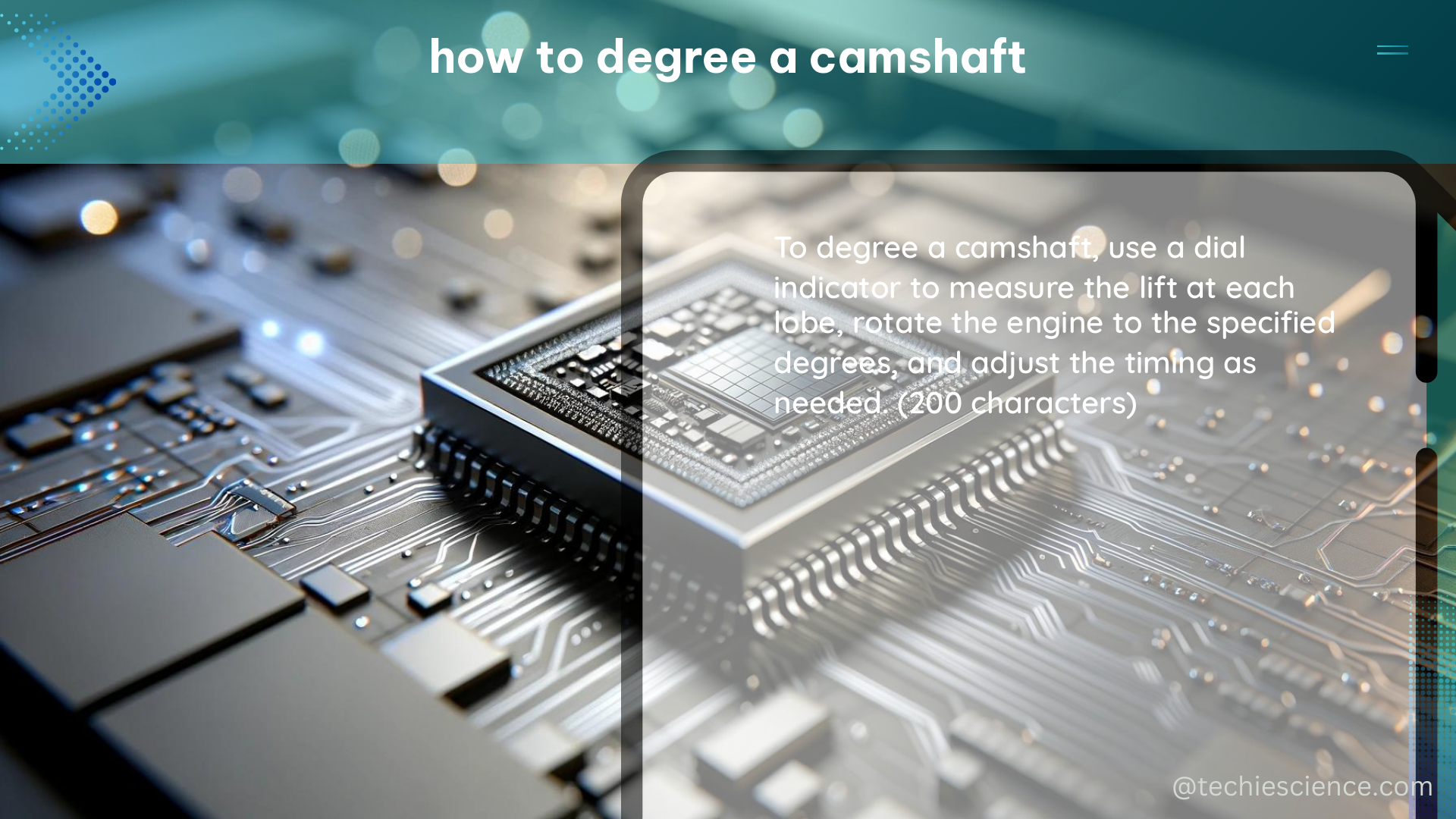Degreeing a camshaft is a critical process in engine tuning and performance optimization. It involves precisely measuring and adjusting the camshaft’s specifications, such as duration, lift, and valve timing, to ensure the engine operates at its peak efficiency. This comprehensive guide will walk you through the step-by-step process of degreeing a camshaft, providing you with the technical details and expert insights needed to achieve maximum performance from your engine.
Preparing for Camshaft Degreeing
Before you begin the degreeing process, you’ll need to gather the necessary tools and equipment. This includes:
- Degree Wheel: A degree wheel is a tool that attaches to the crankshaft pulley and allows you to measure the engine’s rotation in degrees.
- Dial Indicator: A dial indicator is used to precisely measure the lift of the camshaft as the engine rotates.
- Camshaft Degree Plate: This specialized tool helps you accurately position the camshaft during the degreeing process.
- Feeler Gauges: Feeler gauges are used to measure the clearance between the valve and the valve train components.
- Timing Light: A timing light is used to synchronize the camshaft and crankshaft positions.
Removing the Cam Cover

The first step in degreeing a camshaft is to remove the cam cover, which provides access to the camshaft. This process may vary depending on the specific engine, but generally, you’ll need to:
- Disconnect the battery and any electrical connections to the cam cover.
- Locate and remove the cam cover bolts, typically using a socket wrench.
- Carefully lift the cam cover off the engine, taking care not to damage the gasket or any components.
Installing the Degree Wheel and Dial Indicator
With the cam cover removed, you can now install the degree wheel and dial indicator:
- Degree Wheel Installation: Attach the degree wheel to the crankshaft pulley, ensuring it is securely in place and can rotate freely.
- Dial Indicator Placement: Position the dial indicator so that the tip rests on the valve train component, such as the valve shim or rocker arm. Adjust the indicator to measure the lift of the camshaft as the engine rotates.
Rotating the Engine and Measuring Camshaft Specifications
Now, it’s time to rotate the engine and measure the camshaft’s specifications:
- Rotate the Engine: Slowly rotate the engine by hand, observing the dial indicator and degree wheel simultaneously.
- Measure Lift: Record the maximum lift of the camshaft, as well as the degrees of rotation at which the lift occurs.
- Measure Duration: Calculate the duration of the camshaft by measuring the number of degrees between the opening and closing of the valve.
- Measure Valve Timing: Determine the degrees of rotation at which the intake and exhaust valves open and close.
Adjusting the Camshaft
If the camshaft’s specifications do not match the manufacturer’s recommendations, you may need to adjust the camshaft’s position:
- Loosen the Camshaft Bolts: Carefully loosen the camshaft bolts, taking care not to move the camshaft.
- Rotate the Camshaft: Using the camshaft degree plate, rotate the camshaft to the desired position, aligning the centerline of the lobes with the manufacturer’s specifications.
- Tighten the Camshaft Bolts: Securely tighten the camshaft bolts, ensuring the camshaft is locked in the correct position.
Verifying the Camshaft Specifications
After adjusting the camshaft, it’s essential to verify that the specifications are within the manufacturer’s recommended range. Repeat the measurement process to ensure the camshaft is properly degreed.
Reinstalling the Cam Cover
Once you’re satisfied with the camshaft’s specifications, you can reinstall the cam cover:
- Apply Sealant: Apply a thin layer of high-quality sealant to the cam cover gasket surface.
- Reinstall the Cam Cover: Carefully lower the cam cover back into place, ensuring the gasket is properly seated.
- Tighten the Bolts: Tighten the cam cover bolts in a criss-cross pattern, following the manufacturer’s recommended torque specifications.
- Reconnect Electrical Connections: Reconnect any electrical connections that were previously disconnected.
Conclusion
Degreeing a camshaft is a critical step in engine tuning and performance optimization. By precisely measuring and adjusting the camshaft’s specifications, you can unlock the full potential of your engine and achieve maximum performance. This comprehensive guide has provided you with the technical details and expert insights needed to successfully degree a camshaft, empowering you to take your engine’s performance to the next level.
References:
– Using a Degree Wheel to Determine Cam
– How to Degree a Camshaft
– How to Degree a Camshaft

The lambdageeks.com Core SME Team is a group of experienced subject matter experts from diverse scientific and technical fields including Physics, Chemistry, Technology,Electronics & Electrical Engineering, Automotive, Mechanical Engineering. Our team collaborates to create high-quality, well-researched articles on a wide range of science and technology topics for the lambdageeks.com website.
All Our Senior SME are having more than 7 Years of experience in the respective fields . They are either Working Industry Professionals or assocaited With different Universities. Refer Our Authors Page to get to know About our Core SMEs.